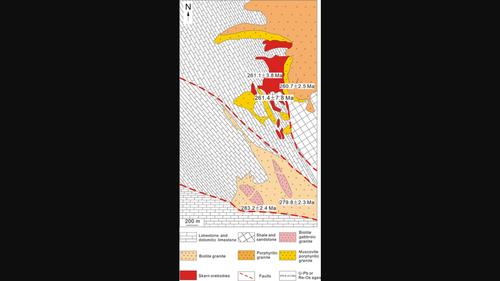当前位置:
X-MOL 学术
›
Resour. Geol.
›
论文详情
Our official English website, www.x-mol.net, welcomes your
feedback! (Note: you will need to create a separate account there.)
Extremely fractionated magmas linked with W mineralization: Evidence from the Lyangar W-Mo deposit, South Tianshan Orogenic Belt
Resource Geology ( IF 1.1 ) Pub Date : 2022-09-25 , DOI: 10.1111/rge.12301 Xianghui Fei 1 , Zhaochong Zhang 1 , Zhiguo Cheng 1 , M. Santosh 1, 2 , Zhenzhen Gao 1 , Bakhtiar Nurtaev 3
Resource Geology ( IF 1.1 ) Pub Date : 2022-09-25 , DOI: 10.1111/rge.12301 Xianghui Fei 1 , Zhaochong Zhang 1 , Zhiguo Cheng 1 , M. Santosh 1, 2 , Zhenzhen Gao 1 , Bakhtiar Nurtaev 3
Affiliation

|
Tungsten (W) deposits are commonly related to the exsolution of magmatic-hydrothermal fluids from high-Si granites (SiO2 > 70%). However, whether the W-related high-Si granitic magma is produced via partial melting of metasedimentary source rocks or by high degree of fractional crystallization remains controversial. Here we present new geochronological and geochemical data on the intrusions associated with the Lyangar W-Mo skarn deposit in the Southern Tianshan Orogenic Belt, Uzbekistan. Our new U–Pb zircon age data show that the major intrusion exposed in the region are ca. 280 Ma biotite gabbroic diorite and biotite granite and about 260 Ma porphyritic granite and muscovite porphyritic granite. The molybdenite grains in the skarn rocks and orebodies show weighted Re-Os ages of 261.4 ± 7.8 Ma and 261.1 ± 3.8 Ma, respectively. In combination with the field contact, we confirm that the muscovite porphyritic granite is genetically related to the W mineralization. The gradual transition from the porphyritic granite to muscovite porphyritic granite, similar mineral assemblages and geochemical variations indicate that they are co-magmatic, and that the porphyritic granite represents less evolved member. Rhyolite-MELTS modeling further reinforces that the muscovite porphyritic granites can be produced by high degree of fractional crystallization (~33%, including ~1.2% biotite, ~27% plagioclase, ~2% alkali-feldspar, ~0.21% Fe-Ti oxides, and ~2.7% amphibole) of the porphyritic granite magma. On the basis of the positive ƐHf(t) values (+3.03 to +6.02), high-SiO2 contents and CIPW characters, the porphyritic granite is considered to have formed from dehydration melting at low pH2O of juvenile basaltic source rocks around 16 kbar and 850–1000°C. Our study demonstrates that extreme fractional crystallization of granitic magma plays a significant role in W enrichment in the granitic melt.
中文翻译:

与 W 成矿作用相关的极端分馏岩浆:来自南天山造山带 Lyangar W-Mo 矿床的证据
钨 (W) 矿床通常与岩浆热液从高硅花岗岩 (SiO 2 > 70%)。然而,与W相关的高硅花岗质岩浆是由变质沉积烃源岩的部分熔融产生还是由高度的分级结晶产生的,仍存在争议。在这里,我们展示了与乌兹别克斯坦南天山造山带 Lyangar W-Mo 矽卡岩矿床相关的侵入体的新的地球年代学和地球化学数据。我们新的 U-Pb 锆石年龄数据表明,该地区暴露的主要侵入体约为 100 年。280 Ma黑云母辉长闪长岩和黑云母花岗岩,约260 Ma斑状花岗岩和白云母斑状花岗岩。矽卡岩岩石和矿体中的辉钼矿颗粒显示的 Re-Os 加权年龄分别为 261.4 ± 7.8 Ma 和 261.1 ± 3.8 Ma。结合现场接触,我们确认白云母斑状花岗岩与W矿化有遗传关系。从斑状花岗岩到白云母斑状花岗岩的逐渐过渡,相似的矿物组合和地球化学变化表明它们是共岩浆的,而斑状花岗岩是较少演化的成员。流纹岩-MELTS 模型进一步强化了白云母斑状花岗岩可以通过高度分级结晶产生(~33%,包括~1.2% 黑云母、~27% 斜长石、~2% 碱长石、~0.21% Fe-Ti 氧化物, 和~2.7% 闪石) 的斑状花岗岩岩浆。在正 Ɛ 的基础上 流纹岩-MELTS 模型进一步强化了白云母斑状花岗岩可以通过高度分级结晶产生(~33%,包括~1.2% 黑云母、~27% 斜长石、~2% 碱长石、~0.21% Fe-Ti 氧化物, 和~2.7% 闪石) 的斑状花岗岩岩浆。在正 Ɛ 的基础上 流纹岩-MELTS 模型进一步强化了白云母斑状花岗岩可以通过高度分级结晶产生(~33%,包括~1.2% 黑云母、~27% 斜长石、~2% 碱长石、~0.21% Fe-Ti 氧化物, 和~2.7% 闪石) 的斑状花岗岩岩浆。在正 Ɛ 的基础上Hf(t)值(+3.03~+6.02)、高SiO 2含量和CIPW特征,认为斑状花岗岩是由16 kbar附近和850-1000的玄武质幼年烃源岩在低pH 2 O条件下脱水熔融形成的摄氏度。我们的研究表明,花岗质岩浆的极端分级结晶在花岗岩熔体中的 W 富集中起重要作用。
更新日期:2022-09-26
中文翻译:

与 W 成矿作用相关的极端分馏岩浆:来自南天山造山带 Lyangar W-Mo 矿床的证据
钨 (W) 矿床通常与岩浆热液从高硅花岗岩 (SiO 2 > 70%)。然而,与W相关的高硅花岗质岩浆是由变质沉积烃源岩的部分熔融产生还是由高度的分级结晶产生的,仍存在争议。在这里,我们展示了与乌兹别克斯坦南天山造山带 Lyangar W-Mo 矽卡岩矿床相关的侵入体的新的地球年代学和地球化学数据。我们新的 U-Pb 锆石年龄数据表明,该地区暴露的主要侵入体约为 100 年。280 Ma黑云母辉长闪长岩和黑云母花岗岩,约260 Ma斑状花岗岩和白云母斑状花岗岩。矽卡岩岩石和矿体中的辉钼矿颗粒显示的 Re-Os 加权年龄分别为 261.4 ± 7.8 Ma 和 261.1 ± 3.8 Ma。结合现场接触,我们确认白云母斑状花岗岩与W矿化有遗传关系。从斑状花岗岩到白云母斑状花岗岩的逐渐过渡,相似的矿物组合和地球化学变化表明它们是共岩浆的,而斑状花岗岩是较少演化的成员。流纹岩-MELTS 模型进一步强化了白云母斑状花岗岩可以通过高度分级结晶产生(~33%,包括~1.2% 黑云母、~27% 斜长石、~2% 碱长石、~0.21% Fe-Ti 氧化物, 和~2.7% 闪石) 的斑状花岗岩岩浆。在正 Ɛ 的基础上 流纹岩-MELTS 模型进一步强化了白云母斑状花岗岩可以通过高度分级结晶产生(~33%,包括~1.2% 黑云母、~27% 斜长石、~2% 碱长石、~0.21% Fe-Ti 氧化物, 和~2.7% 闪石) 的斑状花岗岩岩浆。在正 Ɛ 的基础上 流纹岩-MELTS 模型进一步强化了白云母斑状花岗岩可以通过高度分级结晶产生(~33%,包括~1.2% 黑云母、~27% 斜长石、~2% 碱长石、~0.21% Fe-Ti 氧化物, 和~2.7% 闪石) 的斑状花岗岩岩浆。在正 Ɛ 的基础上Hf(t)值(+3.03~+6.02)、高SiO 2含量和CIPW特征,认为斑状花岗岩是由16 kbar附近和850-1000的玄武质幼年烃源岩在低pH 2 O条件下脱水熔融形成的摄氏度。我们的研究表明,花岗质岩浆的极端分级结晶在花岗岩熔体中的 W 富集中起重要作用。









































 京公网安备 11010802027423号
京公网安备 11010802027423号